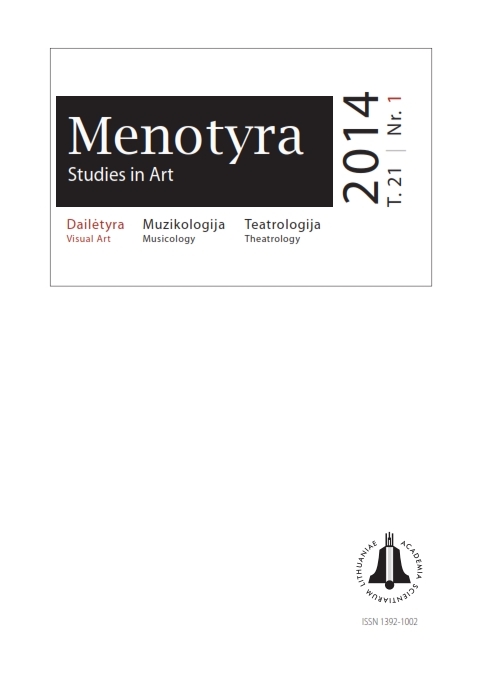Apie šv. Jeronimo atvaizdus ir jų ištakas Lietuvoje
On the images of St. Jerome and their origins in Lithuania
Author(s): Skirmantė Smilingytė-ŽeimienėSubject(s): Christian Theology and Religion, Fine Arts / Performing Arts, Visual Arts, Theology and Religion
Published by: Lietuvos mokslų akademijos leidykla
Keywords: St. Jerome; Church Fathers; noble class; European visual art; visual art in Lithuanian churches; proto-image
Summary/Abstract: It would be correct to say that St. Jerome is not a very popular saint in Lithuania. His Lithuanian bibliography is rather scarce, and his images on church altars are few and not widely recognizable. On the other hand, the Lithuanian “history” of St. Jerome is also little known. The teaching and works of this Church Father, his piety, remarkable industriousness and erudition were much better realized by the believers of the 16th–17th centuries, particularly those belonging to the noble class, than they are today. The personality of this saint played quite an important role in the process of Lithuania’s Christianisation and the intellectual growth of Lithuanian society, as this process took place at the time (from the 14th to the 17th centuries) when Western Europe was particularly fascinated with St. Jerome, and a great many eminent works of different iconography related with this saint were created. In the early 15th century a relic of the translator of the Vulgate was held in the Vilnius Cathedral, and his works could be found in libraries. It was along with the illustrations of incunabula and palaeotypes that the first images of St. Jerome reached Lithuania. The images of the saint in Lithuanian churches mainly appeared in the 16th – first half of the 19th century, though there are later ones as well (e. g., in the Joniškis church). One of the forms of respect for St. Jerome – the increasing popularity of his name among the well-off citizens in the 16th–17th centuries – prompted the appearance of artworks endowed by patrons in churches (e. g., St. Jerome is represented in the titular painting of the Plokščiai church, endowed by the treasurer and scribe of the Lithuanian land, Hieronim Kirszenstein, in 1670; images of the endower’s heavenly patron could be found in the Klovainiai and Tytuvėnai churches, as well as the Šiauliai Church of St. Peter and St. Paul, endowed by the Samogitian elder Hieronim Wołłowicz in the first half of the 17th century). The images of St. Jerome appeared in churches of a rich iconographic programme and décor. As can often be seen in the compositional schemes of the borders on the title pages of some early books, in churches St. Jerome is most often represented along with the other Fathers of the Western Church. The customary locations of the “pillars” of the Christian doctrine are ideologically important: altar retables (sculptures in the Vilnius Church of the Holy Spirit, the Joniškis and Debeikiai (no longer extant) churches, and paintings in the Merkinė church), pulpits (sculptures in the Telšiai or Varniai cathedrals), church vaults (mural paintings in the Pažaislis and Jieznas churches, the Vilnius Church of the Holy Spirit and St. George’s Church, sculptures in the Vilnius Church of St. Peter and St. Paul), or liturgical vessels (e. g. monstrances created by the Vilnius goldsmith Jonas Laris in the Dūkštai church or St. John’s Church in Vilnius). St. Gregory, St. Augustine, St. Ambrose and St. Jerome are considered the continuers and consolidators of the works of the four evangelists and thus in the iconographical tradition are often represented together with the latter, although in the hierarchical order: the evangelists are placed higher than their symbolical doubles (e. g. in the altar of St. Thomas of Aquin in the Vilnius Church of the Holy Spirit, on the vaults and the high altar of the Joniškis church, and on the canopy and platform of the pulpit of the Telšiai Cathedral).Quite often the iconography of St. Jerome’s paintings and sculptures is adopted from the proto-image – often an engraving created after a painting by a famous artist. For example, it is quite possible that while creating a painting of St. Jerome for the Alsėdžiai church, an unknown Lithuanian artist of the first half of the 19th century referred to the engravings by the printmakers Domenico Cunego or Joseph Fusselli, which were popular in the second half of the 18th – first half of the 19th century, rather than the original visual source – a painting by Guido Reni held at the National Gallery in London. Copper engravings by the Netherlandish printmakers Johann ( Jan) I Sadeler or Johann Baptist Zangrius from the last quarter of the 16th century – early 17th century undoubtedly served as the visual source for a small painting of St. Jerome in the Merkinė church. The predecessors of the ceiling composition of the Jieznas church can be found among the works by the Southern German artists Anton Weiss or Gottfried Bernhard Goetz from the1760s, which are cognate to Ribera’s paintings on a similar topic. The iconographic model of Guercino’s painting held in a private collection can be traced in the composition of a lunette in St. George’s Church in Vilnius.
Journal: Menotyra
- Issue Year: 21/2014
- Issue No: 1
- Page Range: 14-33
- Page Count: 20
- Language: Lithuanian

